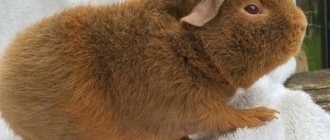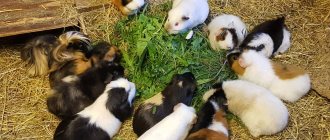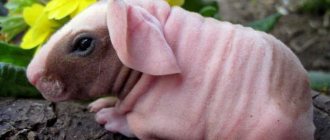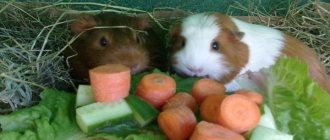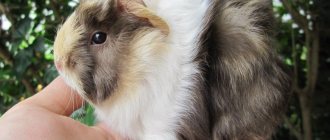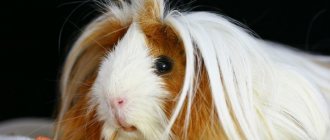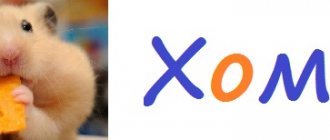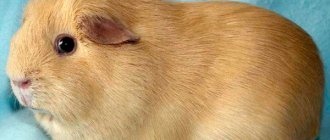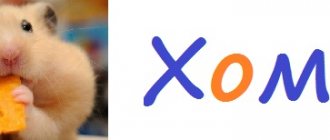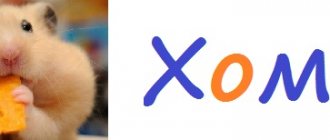Guinea pigs are ideal for keeping as pets. There are a variety of pig breeds, however, special attention should be paid to the Peruvian guinea pig.
The history of the emergence of this species is lost in the depths of past centuries. It is only known that the first representatives of the breed were brought to Europe in 1800 from the countries of South America - Peru, Argentina or Brazil.
The general public became acquainted with the animals at the Paris Agricultural Exhibition, after which a breed standard was formulated and approved in 1930.
Story
Where do the Peruvian breed of guinea pigs come from, how did they appear? Why do they have such long fur? Due to the unusual appearance of the rodent, it can be assumed that Peruvian guinea pigs were bred artificially, like, for example, the skinny breed. But no, “Peruvians” appeared in nature, naturally.
Peruvian guinea pigs are native to South America; to be more precise, according to scientists, they are from Bolivia, Argentina and, of course, from Peru - it is from the place of passage that their name appeared. In the 16th century, this breed was brought by traders from Europe to France. In this country, pigs were kept as pets and were worth a lot of money. These pigs also came to other European countries and to the UK from France, to subsequently become an attribute of fashion and win the hearts of people and the interest of breeders all over the world.
In Europe, the popularity of this breed reached its peak in the mid-19th century. For the first time, at an exhibition of agricultural goods in Paris at the end of the 19th century, these animals were presented to the public and captured in photographs. Initially, only three breeds of pigs were exhibited in America: Abyssinian, smooth-haired and long-haired Angora. In the 1930s, the breed name "Angora" was changed to "Peruvian", resulting in confusion that continues today. In some countries, when breeding this breed, it is still given the name “Angora”, with standards and rules specifically for the Peruvian breed.
Currently, this breed of guinea pigs is officially recognized in many countries. In the Russian Federation, such pigs are also quite popular. Despite the fact that many breeders breed this breed, it is not so easy to find them for sale.
Appearance
The Peruvian guinea pig has such a bright and impressive appearance that it is almost impossible to make a mistake and confuse it with representatives of other breeds. The main distinguishing features of the animals:
- short body;
- large head;
- broad shoulders.
And pride and, undoubtedly, the main distinguishing feature of the Peruvians is their completely straight, thick and unusually silky fur, up to 15–20 cm long. The coat is so thick that, looking closely at the animal, you cannot immediately determine where the muzzle is and where the tail is.
And of course, many people think that caring for wool of this quality is a difficult and troublesome task. Practice shows that this is not entirely true. The fur does not tangle and is very easy to comb. It's all about the rosettes, of which Peruvians have 2 on the body and a peculiar swirl on the nose. The rosette in pigs is the starting point for the growth of fur in a circle.
On the head, strands of fur fall over the eyes, covering almost the entire muzzle of the rodent. On the back, the fur is placed in an even parting. But on the paws and belly the fur is very short, and it’s easy to care for.
Peruvian guinea pigs come in a variety of colors and patterns. For example, one-colored Peruvian selfies and two-colored pigs are known, but a three-colored animal is a rare curiosity.
Adult animals grow up to 1.8 kg. With proper care, the life expectancy of animals is about 8 years.
Behavior
Peruvian guinea pigs have a fairly calm character. They are friendly, welcoming, love affection and care, and enjoy playing.
Peruvians simply need to play and exercise a lot to keep them in good health, so games are not only fun, but also a guarantee of good health, so let your pet play and run around more often.
Despite the fact that pigs are playful and move around a lot, they prefer rest and a calm environment. Rodents feel uncomfortable when there is a noisy environment and a lot of movement. They need to be treated with care, and having small children in the family is not the most suitable option for them.
Content
Caring for Peruvians is not very different from caring for other representatives of the species. They also need a spacious cage from which the rodent is periodically released for a walk around the house or apartment.
Buying a wheel, as many inexperienced owners like to do, is not advisable due to the fact that pigs rarely use them. But other toys will come in handy.
Sawdust or wood shavings are used as bedding. It is not recommended to use granules: not only can they cause calluses on the paws, but they will also become embedded in the fur.
In nutrition, preference is given to vegetables and fruits, hay and grain. You can also purchase premium ready-made food for long-haired breeds, which will be fully balanced. Do not forget about the daily supply of vitamin C (it is added to the water), as well as periodic feeding with vitamins and microelements so necessary for a beautiful coat (vitamins A, B, sulfur, etc.).
It is recommended to bathe Peruvians only in case of urgent need or before an exhibition. Use special shampoos and conditioners for easy combing. After water procedures, the pig should be thoroughly blotted with a towel and dried with a hairdryer. Avoid drafts. Otherwise, the animal will catch a cold or even catch pneumonia.
Pregnancy and offspring
Guinea pigs give birth without much difficulty. The pig reaches sexual maturity at 5 weeks after birth, and males at 10 weeks. Despite this, a female should not give birth early, as this may cause harm to her. The most suitable period for breeding is after 12 weeks.
But giving birth too late can also be unsafe. It is prohibited to breed guinea pigs if the female is over two years old. The pregnancy of this rodent lasts an average of 63 days; in one birth, the female gives birth to 2–4 babies. They are born strong and strong and immediately after birth they are able to move independently. After birth, little pigs need to be housed separately for 3-4 weeks.
Reproduction
The main difficulties associated with breeding these animals at home are the correct selection of a pair to ensure the birth of healthy and strong offspring. Animals that have reached six months of age, but not older than two years, are allowed to crossbreed.
Females come into the hunt, which lasts about 12 hours, on average once every 15 days. Gestation of the cubs takes 68 days. In this case, one female gives birth to two to four pigs.
Temperament and behavior
Representatives of the breed have an extremely flexible character. These are cute, extremely affectionate and obedient animals, they love to have fun and play and appreciate when they are surrounded by attention. The animal should have the opportunity to engage in active games every day, since movement for pigs is not just a pleasant pastime, but the key to harmonious physical development and health.
However, it is important not to overdo it with active games; Peruvian pigs are supporters of silence and comfort. They may become stressed in a noisy and hectic environment. It is for this reason that families with small children should not have such pigs.
Peruvian pigs usually reproduce without problems. Sexual maturity in females occurs at the age of 5 weeks, and in males at 10. However, they can be bred no earlier than 3 months, because early birth can harm the health of young pigs. Late births are also dangerous to health, so pigs over 2 years old are not allowed for breeding.
After approximately 63 days of pregnancy, gilts give birth to 2 to 4 babies. Newborns are distinguished by their large size and the ability to move independently on the very first day. Already at the age of 3-4 weeks, young pigs require separation from their mother.
Maintenance and nutrition
A guinea pig is not small in size, so it needs a fairly large cage - 70 by 80 cm and a height of 50 cm is perfect. The pig is quite large and for comfort it needs a lot of space to move freely. The cage with the animal must be placed in a well-lit, windproof place.
The animals have good immunity, but despite this, they should not be in the cold, as they can catch a cold - even though they have thick and warm fur. From time to time, you can let your guinea pig run around the house outside of its cage. But be sure to keep an eye on it - the animal may crawl or hide somewhere, and then you will have to work hard to find it.
Peruvians also have rather sharp teeth. Therefore, if you have released an animal, be prepared for the fact that it may chew on the wooden furniture in the house. Pigs' teeth do not stop growing throughout their lives, so it is necessary to give your pets solid food so that their teeth wear down and are not too sharp.
Nutrition
Guinea pigs' food should consist of the following products:
- corn;
- hay;
- grass;
- seeds;
- vegetables and fruits;
- special treats for guinea pigs from specialized pet stores;
- dry food in granules.
The animal needs to be fed twice a day, preferably in the morning and evening. Feeding the pig multiple times is allowed, but in small portions. In the warm season, one adult guinea pig eats about half a kilogram of fresh grass and 50 grams of oats per day.
As an additional supplement, 20 grams of milk are introduced into the diet of pregnant and lactating guinea pigs. The diet of guinea pigs is periodically enriched by adding vitamin-mineral complexes to the food.
Guinea pigs eat everything that other rodents do: fruits, vegetables, grass or old hay. Peruvians especially love to eat apples because they are juicy and sweet. Apples also contain a lot of vitamin C, which is essential for animals. By the way, vitamin C is found in large quantities in hay.
You can also feed the pig with specialized food, which is sold in pet stores. It also contains many useful substances that the animal needs both to maintain health and for the beauty and thickness of its coat.
Choosing and arranging a home
For a Peruvian guinea pig, you need to purchase a spacious cage, terrarium or enclosure.
All equipment must be durable and reliable so that food does not spill or water spills. In a spacious cage, you can equip a separate toilet, because pigs like to go to one place. This simplifies the cleaning that needs to be done daily.
It is best to place the cage in well-lit areas.
Keeping animals in a dark corner of the room has an adverse effect on the health and behavior of the rodent, so breeders are urged to place the cage near a window. However, in this case, drafts, which are destructive for Peruvians, should be carefully avoided.
It is very important that the place to sleep is comfortable. It is not recommended to buy houses, because pigs can hide there and become unsociable. It is better to choose a hammock or tunnel made of soft material.
Guinea pig care
The Peruvian guinea pig requires more attention than, for example, a representative of the short-haired breed, so it is advisable to get a Peruvian when you already have experience in keeping guinea pigs.
It is also not recommended to have such a pet for children. If a child really wants a rodent, give him a smooth-haired pig - there will be less worries with it, and the same pleasure. Breeding Peruvian guinea pigs should be carried out by enthusiasts or people who have experience in this matter, as well as the desire and ability to do this.
Peruvian pigs need to be brushed and combed every day , if desired, do this several times a day. The pig should be combed with a simple baby or small comb. Special combs, which you can purchase at a pet supply store, are also perfect. If your plans do not include exhibiting your pet at exhibitions and demonstrations, then it is advisable to frequently trim its fur to the required length - so that it does not hang too much and dirt, pieces of hay, and food do not accumulate in it, and so that the animal can move without difficulty .
If you show your pig at shows, figure out how to protect its fur while the animal is in the cage. You can tie it, braid it. It is not recommended to bathe these pets, but for this long-haired breed it is still possible. Do this infrequently - once every one or two months will be enough. When washing, you can use shampoo for rodents, or you don’t have to use special products.
In general, the Peruvian guinea pig will be an excellent pet for you, a wonderful friend and a full-fledged member of the family, with its own interests. You and your loved ones will definitely love it, so when choosing a pet, pay attention to this animal.
The Peruvian breed of guinea pigs is one of the oldest among long-haired breeds. In addition, this breed is rightfully considered the most beautiful. These guinea pigs are frequent guests at various exhibitions, where they create a real sensation among visitors. Chic appearance and easy-going, friendly character helped make this breed of guinea pigs popular. Therefore, it is not surprising that many people want to get as much information as possible about Peruvian Longhaired Guinea Pigs.
Content
In terms of maintenance and care, Peruvian guinea pigs are more demanding animals compared to other short-haired breeds. Given this factor, it is not recommended to purchase such pigs as your first guinea pig. The same applies to purchasing long-haired Peruvian pigs for children. As a gift for a child, a short-haired guinea pig is better suited, as it will bring no less joy, but there will be much less hassle with its care.
Care
Your pet's coat should be brushed every day. Even a regular baby comb is suitable for this, although if you wish, you can invest in a special brush for combing out animal hair. From time to time the coat will have to be shortened in some places (on the head and paws). This is due to the fact that hair on the head can interfere with normal vision, and long hair on the paws will hinder the pet’s movements.
Grooming
In addition to daily combing and shortening the coat as necessary, caring for the animal’s coat involves bathing it once every 1.5 months. This procedure can be easily carried out either in the bathtub or in a regular bowl or even a sink. To bathe a rodent, special shampoos are used, which can be purchased at a regular pet store.
Conditions of detention
The Peruvian pig is an extremely active and agile animal. They should always be allowed to run around in an open space, or even better in the fresh air. They love a variety of tunnels and hammocks, which are recommended to equip the cage with.
However, when walking you need to be extremely careful, because the animal can run away and not only ruin things in the apartment, but also harm itself.
It is not recommended to use harnesses for outdoor walks, wheels and balls. Peruvian guinea pigs tolerate them with difficulty; the use of such devices can lead to broken bones in pets.
Running is extremely beneficial for pigs. In summer, you can walk the animal outside or take it with you on trips. Just prepare a carrier bag and take food and water with you. It is advisable for the animal to spend a lot of time in the company of people, playing and running.
It is recommended to equip the cage with a “mineral stone” so that the rodent sharpens its teeth. This measure will help maintain the environment while your pet is walking.
Body structure
The body of these guinea pigs can reach a length of up to 30 centimeters, although larger individuals are also found. The weight of the animal does not exceed 1.2-1.5 kilograms. The physique of the pig is distinguished by good muscles and a stocky structure. the pig has a developed and wide head, a strong shoulder girdle, and a flat back. The tail is missing. Dark large shiny eyes. Ears weigh. The body of the animal, including its head, is densely covered with long, smooth hair, whose length can reach 50 centimeters. The hairline is divided along the vertebral line by a parting.
The hair on the head almost completely blocks the animal's vision, so it is recommended to regularly shorten the hair here. As for the colors of these pigs, it can be either suited or consist of three suits. Most often, pigs' fur is white with red and brown spots.
Care
The main difficulties are related to wool. A thick fur coat requires careful, daily and painstaking combing. True, the process is not particularly labor-intensive due to the fact that wool is not prone to tangling and tangles.
To achieve proper gloss, it is recommended to use a soft brush and a wide-toothed comb. If the pig is combed correctly, it will look like a real wig.
During breaks between exhibitions, the wool is wound on curlers. In a twisted state, it is less tangled and clogged. And it will be much more convenient for the rodent itself to move, eat and lead an active life.
By the way, these pigs can and even need to be cut. A haircut makes it much easier to comb your hair, and your hair takes on a healthier and more well-groomed appearance.
The breed is a decorative and show breed, so it is not particularly suitable for children or beginners. Meticulous care can quickly become boring, and the pig will suffer from unkempt fur.
Rules for choosing when purchasing and price
It is recommended to buy a pet in specialized pet stores or from reputable breeders with an impeccable reputation. At pet markets or on the Internet, the cost of such an animal will be noticeably lower than in special nurseries and pet stores. However, it is worth considering that no one on the market can guarantee you that the animal will be completely healthy, as well as its purebred.
When choosing a pig, it is important to pay attention to the smallest details in its appearance and behavior. The health of the pig is indicated by:
- moderate body fatness;
- clean iridescent and shiny wool;
- clean fur in the anus area;
- lack of liquid stool;
- active behavior;
- lively eyes with a pronounced shine;
- dry paws;
- clean and straight teeth;
- absence of discharge in the mucous membranes of the mouth, nose and eyes.
Guinea pig breeds with photos: Abyssinian guinea pig
This is the most famous, famous and long-standing category of individuals of these animals. The characteristic properties of this breed is the presence of symmetry of rosettes (the fur is evenly divided into lobes, forming coils). Their number may fluctuate, but if the pig is a candidate for exhibition places, then the number of rosettes must be at least eight, clearly defined, pieces. The fur is usually rough to the touch. The presence of various colors and colors usually pleases the buyer's eye, and there are whiskers around the nose, which is not seen in all breeds.
